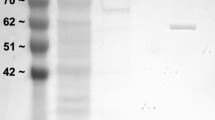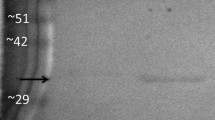Summary
A cystosolic protein kinase that phosphorylates pyruvate kinase (PK) in vitro has been identified in crude homogenates of heart, radular retractor, and foot muscle from the anoxia-tolerant marine whelk Busycon canaliculatum. Protein kinase action was measured by following changes in PK kinetic parameters: phosphorylated PK has a higher K m value for phosphoenolpyruvate and a lower I50 value for l-alanine. The crude protein kinase readily phosphorylated PK in a Mg2+-and ATP-dependent manner in the absence of any added effector. This activity was not affected by the addition of either cAMP (a stimulator of protein kinase A) or Ca2+ plus phorbol 12-myristate 13-acetate (stimulators of protein kinase C) to the incubation medium. Addition of cGMP to the homogenate, however, increased the rate of PK phosphorylation giving a 3–4-fold increase in the rate of change in PK kinetic parameters that was readily apparent after 5h. Complete time-courses of changes in PK kinetic parameters in the presence and absence of cGMP showed that cGMP increased the rate, but not the final extent, of PK phosphorylation. These results indicate that PK inactivation by enzyme phosphorylation in response to anoxia in whelk tissues may be mediated by a cyclic GMP stimulated protein kinase in response to changing levels of cGMP. This conclusion was further supported by data indicating that the total activity of protein kinase was the same in both anoxic and aerobic animals, and that the total PK phosphatase activity was also constant. Changes in PK phosphorylation during anoxia are not, therefore, the result of changes in the total amount of protein kinase or phosphatase.
Similar content being viewed by others
Abbreviations
- cAMP :
-
adenosine 3′:5′-monophosphate
- cGMP :
-
guanosine 3′:5′-monophosphate
- PK :
-
pyruvate kinase
- PMA :
-
phorbol 12-myristate, 13-acetate
- PEP :
-
phosphoenolpyruvate
- K m :
-
Michaelis constant
- I 50 :
-
inhibitor concentration that reduces enzyme activity by 50%
References
Bodnaryk RP (1983) Cyclic nucleotides. In: Downer RGH, Laufer H (eds) Invertebrate endocrinology, vol 1. Alan R. Liss Inc., New York, pp 567–614
Bosca L, Storey KB (1990) 6-Phosphofructo-2-kinase and glycolytic control in a facultative anaerober Biochim Biophys Acta in press
Brooks SPJ, Storey KB (1989) Influence of hormones, second messengers, and pH on the expression of metabolic responses to anoxia in a marine whelk. J Exp Biol 145:31–43
Claus TH, El-Maghrabi R, Pilkis SJ (1979) Modulation of the phosphorylation state of rate liver pyruvate kinase by allosteric effectors and insulin. J Biol Chem 254:7855–7864
Cohen P (1980) Recently discovered systems of enzyme regulation by reversible phosphorylation. Elsevier/North Holland Biochemical Press, Amsterdam
Connelly PA, Sisk RB, Schulman H, Garrison JC (1987) Evidence for the activation of the multifuctional Ca2+/calmodulin-dependent protein kinase in response to hormones that increase intracellular Ca2+ J Biol Chem 262:10154–10163
Czech MP, Klarland JK, Yagaloff KA, Bradford AP, Lewis RE (1988) Insulin receptor signaling. J Biol Chem 263:11017–11020
Edelman AM, Blumenthal DK, Krebs EG (1987) Protein serine/threonine kinases. Ann Rev Biochem 56:567–613
Feliu JE, Hue L, Hers H-G (1976) Hormonal control of pyruvate kinase activity and of gluconeogenesis in isolated hepatocytes. Proc Nat Acad Sci (USA) 73:2762–2766
Helmerhorst E, Stokes GB (1980) Microcentrifuge desalting: A rapid, quantitative method for desalting small amounts of protein. Anal Biochem 104:130–135
Higgins WJ, Greenberg MJ (1974) Intracellular actions of 5-hydroxytryptamine on the bivalve myocardium-II. Cyclic nucleotide-dependent protein kinases and microsomal calcium uptake. J Exp Zool 190:305–316
Hochachka PW (1980) Living without oxygen. Harvard University Press, Cambridge, MA
Holwerda DA, Kruitwagen ECJ, de Bont AMTh (1981) Regulation of pyruvate kinase and phosphoenolpyruvate, carboxylase activity during anaerobiosis in Mytilus edulis L. Mol Physiol 1:165–171
Kagimoto T, Uyeda K (1979) Hormone-stimulated phosphorylation of liver phosphofructokinase in vivo. J Biol Chem 254:5584–5587
Kemp RG, Foe LG (1983) Allosteric regulatory properties of muscle phosphofructokinase. Mol Cell Biochem 57:147–154
Kohler G, Lindl T (1980) Effects of 5-hydroxytryptamine, dopamine, and acetylcholine on accumulation of cyclic AMP and cyclic GMP in the anterior byssus retractor muscle of Mytilus edulis L. (Mollusca). Pflugers Arch 383:257–262
Krebs E, Beavo J (1979) Phosphorylation-dephosphorylation of enzymes. Ann Rev Biochem 48:923–959
Kuo JF, Wyatt GR, Greengard P (1971) Cyclic nucleotide-dependent protein kinase-XI. Partial purification and some properties of guanosine 3′:5′-monophosphate-dependent protein kinases from various tissues and species of Arthropoda. J Biol Chem 246:7159–7161
Lincoln TM (1983) cGMP-dependent protein kinases. Comp Biochem Physiol 99:62–71
Lincoln TM, Corbin JD (1977) Adenosine 3′:5′-cyclic monophosphate-and guanosine 3′:5′-cyclic monophosphate-dependent protein kinases: possible homologous proteins. Proc Nat. Acad Sci (USA) 74:3239–3243
Lincoln TM, Thompson M, Cornwell TL (1988) Purification and characterization of two forms of cyclic GMP-dependent protein kinase from bovine aorta. J Biol Chem 263:17632–17637
Livingstone DL, Zwaan A de (1983) Carbohydrate metabolism in gastropods. In: Wilbur KM (ed) The mollusca, vol. 1 Academic Press, New York, pp 177–242
Mieskes G, Kuduz J, Söling HD (1987) Are calcium-dependent protein kinases involved in the regulation of glycolytic/gluconeogenetic enzymes. Eur J Biochem 167:383–389
Moruzzi P, Barbiroli B, Monti MG, Tadolini B, Hakim G, Mezzetti G (1987) Inhibitory action of polyamines on protein kinase C association to membranes. Biochem J 247:175–180
Pallen CJ, Sharma RK, Wang JH (1987) Modulation of cAMP effects by Ca2+/calmodulin. Bioessays 2:113–117
Plaxton WC, Storey KB (1984) Phosphorylation in vivo of red-muscle pyruvate kinase from the channelled whelk Busycon canaliculatum, in response to anoxic stress. Eur J Biochem 143:267–272
Plaxton WC, Storey KB (1985) Tissue specific isozymes of pyruvate kinase in the channelled whelk Busycon canaliculatum: enzyme modification in response to environmental anoxia. J Comp Physiol B 155:291–296
Plaxton WC, Storey KB (1986) Glycolytic enzyme binding and metabolic control in anaerobiosis. J Comp Physiol B 156:635–640
Sale EM, Denton RM (1983) Adipose-tissue phosphofructokinase: Rapid purification and regulation by phosphorylation in vitro. Biochem J 232:897–904
Sale EM, Denton RM (1985) β-Adrenergic agents increase the phosphorylation of phosphofructokinase in isolated rat epididymal white adipose tissue. Biochem J 232:905–910
Shick JM, de Zwaan A, de Bont AMT (1983) Anoxic metabolic rate in the mussel Mytilus edulis L. estimated by simultaneous direct calorimetry and biochemical analysis. Physiol Zool 56:56–63
Storey KB (1984) Phosphofructokinase from foot muscle of the whelk, Busycon canaliculatum: evidence for covalent modification of the enzyme during anaerobiosis. Arch Biochem Biophys 235:665–672
Storey KB (1985) A re-evaluation of the Pasteur effect: new mechanisms in anaerobic metabolism. Mol Physiol 8:439–461
Storey KB (1988a) Suspended animation: the molecular basis of metabolic depression. Can J Zool 66:124–132
Storey KB (1988b) Mechanisms of glycolytic control during facultative anaerobiosis in a marine mollusc: tissue specific analysis of glycogen phosphorylase and fructose 2,6-bisphosphato. Can J Zool 66:1767–1771
Storey KB, Kelly DA, Duncan JD, Storey JM (1990) Anaerobiosis and organ-specific control of glycolysis in marine whelk. Can J Zool, in press
Takahashi SY (1985) Characterization of the guanosine 3′:5′-monophosphate-dependent protein kinase from silkworm eggs and analysis of the endogenous protein substrates. J Comp Physiol B 155:693–701
Tremblay J, Gerzer R, Hamet P (1988) In: Grengard P, Robison GA (eds) Advances in second messenger and phosphoprotein research, cyclic GMP in cell function, vol. 22. Academic Press, New York, pp 319–383
Whitwam RE, Storey KB (1990) Organ-specific analysis of the time-course of covalent modification of pyruvate kinase during anaerobiosis in a marine whelk. Physiol Zool 63:222–234
Zwaan A de (1983) Carbohydrate metabolism in bivalves. In: Wilbur (ed) The mollusca, vol. 1. Academic Press, New York, pp 137–175
Zwaan A de, Wijsman HE (1976) Anaerobic metabolism in Bivalvia (Mollusca): characteristics of anaerobic metabolism. Comp Biochem Physiol 54B:313–324
Author information
Authors and Affiliations
Rights and permissions
About this article
Cite this article
Brooks, S.P.J., Storey, K.B. cGMP-stimulated protein kinase phosphorylates pyruvate kinase in an anoxia-tolerant marine mollusc. J Comp Physiol B 160, 309–316 (1990). https://doi.org/10.1007/BF00302597
Accepted:
Issue Date:
DOI: https://doi.org/10.1007/BF00302597




